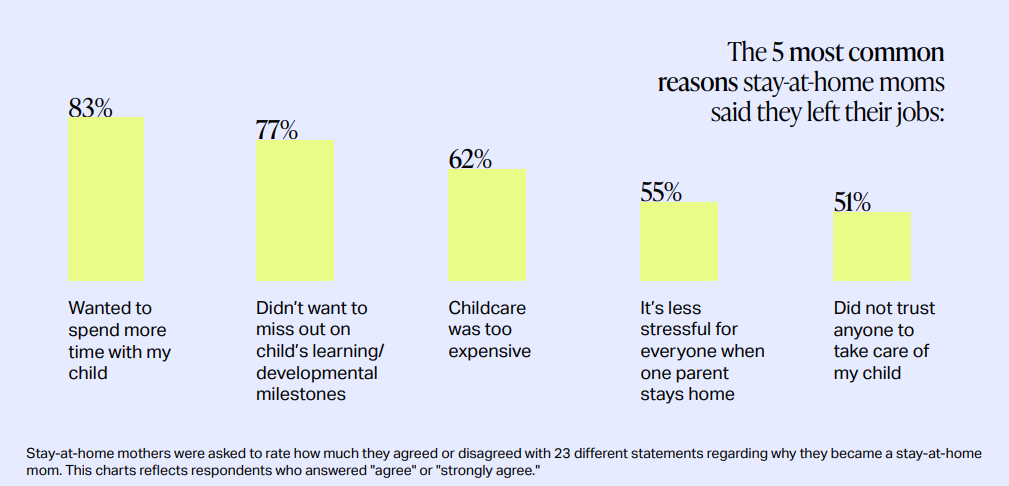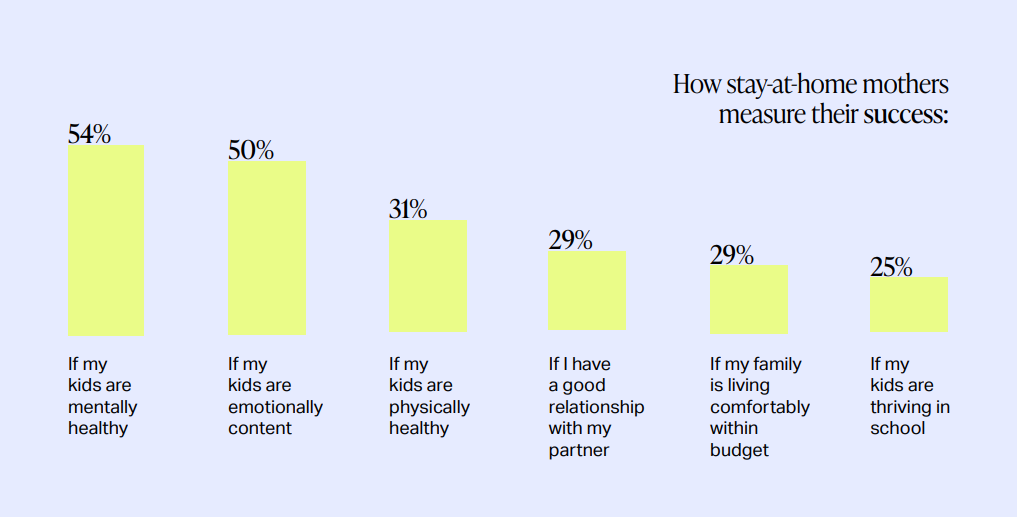Many American mothers are redefining professional success as they press pause on their careers for more family time.
A recent study by Mother Untitled and Proof Insights uncovers the experiences and motivations of these stay-at-home moms. The data provides HR professionals with evidence-based insights to support mothers with career breaks, assisting them in balancing family responsibilities and facilitating a smooth return to work.
Pressed for time? Here’s a quick summary…
- Career break motivation: The most common reason mothers take career breaks is to spend more time with their children, valuing family over work.
- Well-being challenges: Stay-at-home mothers tend to encounter financial stress due to reduced income and may feel isolated and undervalued, impacting their mental and social well-being.
- Skills acquired: During career breaks, mothers develop valuable skills like empathy, effective time management, and innovative problem-solving, improving their professional profile upon re-entry.
- Flexible work arrangements: With 85% of stay-at-home moms seeking flexibility, employers should offer remote work, flexible hours, and/or compressed weeks to support work-life balance.
- Re-entry support: To ease the transition back into the workforce, employers can create phased return programs and establish mentorship connections for returning parents.
Key Findings & Insights
The study surveyed 1,000 members of the general population and 1,200 college-educated stay-at-home and downshifted mothers aged 25 to 54.

Why Moms Press Pause

The top reason mothers pause their careers is to spend more time with their children, with 68% realizing that motherhood is more important than their careers. Many moms are now seeking flexible work arrangements post-pandemic to maintain this family focus.
– Age 29, Full-time stay-at-home mother
Financial Strains
Stay-at-home mothers often weigh the income they give up against quality time with their children. Key financial concerns include:
- Relying on their partner for income (56%)
- Lacking money for leisure activities (52%)
- Lacking emergency savings (41%)
– Age 50, Ready to return to work
Mental Health & Social Dynamics

Stay-at-home mothers prioritize their children’s mental well-being but often neglect their own. This, coupled with shrinking social circles, adversely affects mental health. The majority feel their choice to stay home is undervalued, disrupting their emotional state and re-entry into the workforce.
– Age 37, Ready to return to work
A New Lens On Career Breaks
The surge in career pauses during the pandemic helped normalize these types of breaks. Such periods contribute not only to family bonding but also the development of critical workplace skills:
- Resilience: Parenthood and career breaks cultivate resilience, essential for overcoming workplace obstacles.
- Time management: Balancing caregiving, household chores, and personal goals develops time management skills that are relevant to workplace productivity.
- Adaptability: Adapting to parenting challenges prepares mothers for rapid workplace changes.
- Empathy: Parenthood deepens empathy, a vital quality of emotional intelligence that improves teamwork and leadership.
- Problem-solving: The challenges of caregiving demand creative problem-solving abilities, which are invaluable for finding innovative solutions at work.
Employer Guide For Integrating Parental Support At Work
Effective parental support at work ensures parents can contribute fully without compromising their family commitments. This not only attracts and retains talent, but also fosters diversity, inclusion, and employee well-being.
Flexible Policies & Inclusive Benefits

- Parental leave: Develop comprehensive leave policies for both mothers and fathers, extending beyond standard requirements to support early child development.
- Flexible work arrangements: Flexibility is the top priority for 85% of stay-at-home moms who plan to return to work. Remote work, flexible hours, or compressed workweeks can fulfill this desire. Aligning work schedules with school calendars can further reduce parental stress and enable more quality time with their children.
- On-site or subsidized childcare: The lack of reliable and affordable childcare has caused 2 million women to leave the labor force since February 2020, with 26% citing it as the main reason for their departure. Subsidized or on-site childcare can address a significant barrier to mothers’ workforce participation.
Strategies For A Smooth Re-Entry
- Phased return-to-work programs: Implement return-to-work programs that gradually ease parents into their roles, reducing stress and rebuilding confidence.
- Re-skilling: Support professional growth through subsidized development programs, keeping them industry-relevant.
- Mentorship opportunities: Pair returning parents with mentors for guidance and support during the transition period.
Fostering Whole-Person Well-Being
- Mental health: As parents often overlook their mental well-being, provide counseling and stress management initiatives that support them in this area.
- Physical health: Group fitness classes during work hours promote physical activity and community building among colleagues, often providing the only exercise opportunity for busy mothers.
- Work-life balance: Set boundaries for off-hours communication and build an empathetic culture that supports disconnection when needed.
Cultivating Positive Cultural Shifts
- Parental support networks: Encourage parents to create or join groups where they can exchange experiences and support.
- Leadership’s commitment: Leadership should express their commitment to parents’ well-being and success, creating a ripple effect of support throughout the workforce.
- Feedback loops: Pulse surveys and one-on-one check-ins encourage parents to voice their experiences and suggest improvements, driving better parental support and job satisfaction.
Employee Guide For Smooth & Empowering Career Pauses
Parents considering a career break face a unique set of challenges and opportunities. A well-planned pause can lead to significant personal growth and a stronger re-entry into the workforce.

Preparing For The Pause
- Financial planning: Budget the career break, exploring savings and supplemental income options.
- Communication: If you want to return to your position after the break, discuss your leave plans and potential impacts with your employer, emphasizing a commitment to your role.
Career-Proof Your Break
- Skill development: Take advantage of online platforms like LinkedIn Learning for upskilling. If you remain with your company during your break, ask if there are subsidies for professional development programs.
- Skill recognition and workplace application: Identify skills gained during a career break, like time management from balancing family duties. Prepare examples of how these skills are valuable in the workplace for interviews.
Re-Entering With Strength
- Resume update: Highlight the career break positively, e.g. ‘Career Break – focused on advanced digital marketing studies and family care’.
- Networking: Attend industry webinars or local meetups to re-engage with the professional community.
- Negotiation: Research the market value of your role and prepare to discuss how your added skills benefit the company.












